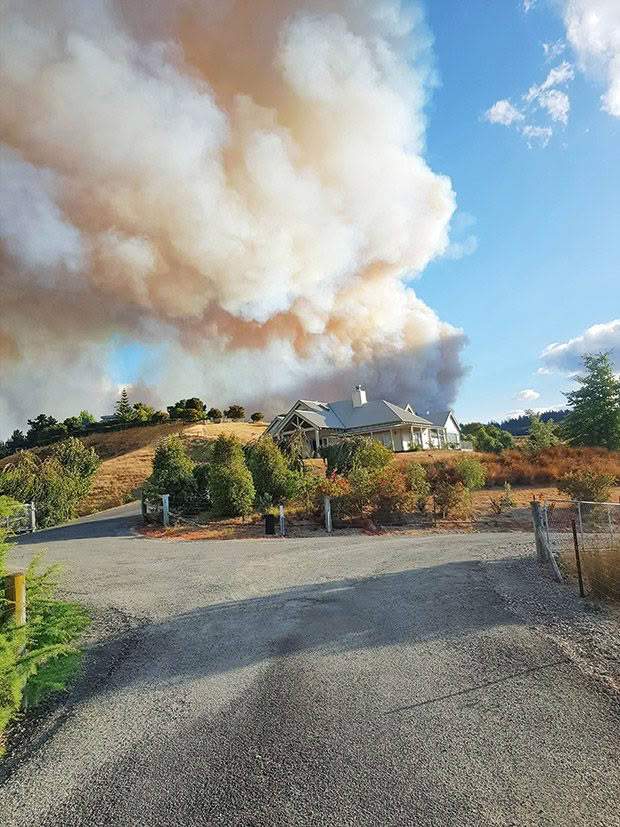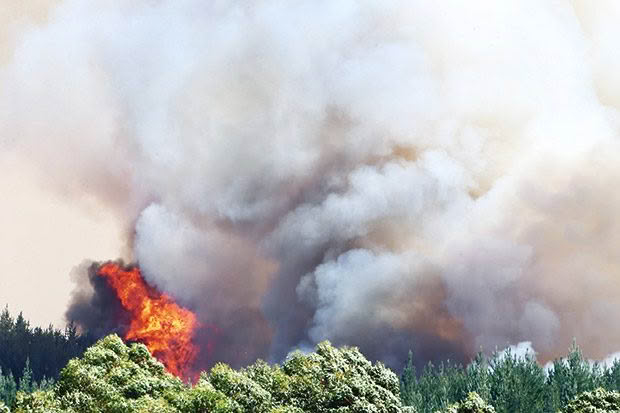4 things to know about rural fires

Guy Mollett thought this was the last time he would see his Redwood Valley home. He took the photo as he was evacuated.
Being ‘fire aware’ can make all the difference for protecting your property.
Words: Annabel Schuler
Fire burns faster going up-hill; the steeper the slope, the faster and more intense the fire. Flames and radiant heat preheat the vegetation ahead of the fire, drying it out and making it burn more easily.
KNOW WHAT A FIRE DAY LOOKS LIKE
Some days are more likely to be a ‘fire day’ than others. From October to April, Fire and Emergency is highly vigilant:
• between 1pm and 6pm;
• when there’s low humidity and high temperatures;
• when hot, dry winds start to pick up.
These provide the perfect environment for a small fire to quickly get out of control. In the 2019 Nelson fires, it’s believed it was one spark, most likely caused by a plough, that kick-started the devastation. The fire went up a hill and was soon out of control, taking a month to put out and covering an area of 2400ha, with a 33km perimeter.
GET RID OF LADDER FUELS
Plants that are left to grow tall and foster dense undergrowth can provide what’s called ‘ladder fuel’. It’s a flammable structure which the fire travels up, igniting the canopies of trees. Fires in canopies are particularly hard to fight.

Heroic fire-fighting and good landscaping meant Guy’s home was saved.
You may not want to remove all the tall trees from around your house, but Fire & Emergency NZ’s Ian Reade recommends:
• cleaning out as many as possible, so canopies aren’t touching, preferably with a 3-6m gap;
• clearing out the undergrowth beneath canopy trees;
• under-planting with low flammability species which could slow a fire down.
BE FIRE AWARE
Ed Bright is a forester near Richmond who has fought fires in New Zealand and Australia. His tip: become ‘fire aware’. His experience, and that of other professionals, shows you should manage the vegetation within 40m of the buildings you wish to protect.
That’s in line with the research coming out of Australia. Ed says it’s also important to get the basics right. “If you think it’s too dry and you can’t get a fire permit, do not light a fire.”
CLEAR OUT WEEDS & ANYTHING DEAD
Some invasive weeds such as gorse and prickly hakea (Hakea sericea) are highly flammable. It’s important to remove even small numbers of these plants regularly.
Some plants retain dead leaves and branches. Pruning out anything dead is another easy way to reduce fire risk.
9 GOOD HOUSEKEEPING HINTS FOR YOUR BLOCK
1. Don’t have plants near the sides of your house;
2. Use low-flammability plants close to buildings;
3. Keep a space between shrubs, and prune off branches 2m above ground.
4. Remove bark gardens running along the sides of a house;
5. Sweep up leaves and other fine material – embers are likely to be blown into the same areas where leaves accumulate;
6. Make sure embers can’t blow under your house, particularly if you store timber or flammable items;
7. Store firewood away from the house, not up against it;
8. Be conscious of flammable items around your house, ie doormats, outdoor furniture – if it’s possible a fire may get close, move them inside;
9. Avoid having native grasses or pampas near buildings;
10. clean gutters out regularly – don’t allow dried leaves to accumulate.
SHOULD YOU LIGHT A FIRE?

Fire & Emergency NZ’s website shows you what the current fire season is in your region, and the forms you need to fill in to apply for a permit.
Fire & Emergency now declares fire seasons and issues fire permits for NZ (urban and rural), not your local council. You still need to comply with city/district and regional council burning restrictions, even if Fire & Emergency issues a permit.
It takes about 5-10 minutes to fill in the forms. A permit will be emailed to you within 5-10 working days, depending on whether a site visit is required. Plan well ahead to make sure you have it in time. www.checkitsalright.nz
What to learn from the worst forest fires in New Zealand (including which trees are most flammable)
Love this story? Subscribe now!
 This article first appeared in NZ Lifestyle Block Magazine.
This article first appeared in NZ Lifestyle Block Magazine.
